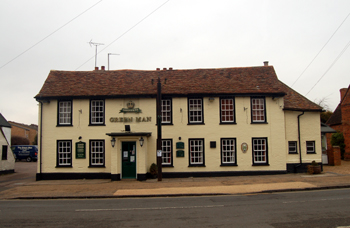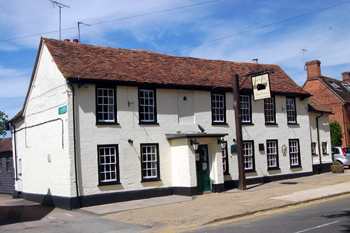The Green Man Public House Clophill
![Green Man about 1920 [Z50/31/51]](/CommunityHistories/Clophill/ClophillImages/Z50-31-51 Green Man about 1920_301x162.jpg)
The Green Man about 1920 [Z50/31/51]
The Green Man Public House [formerly the Shepherd and Dog]: The Green, Clophill
Like the Flying Horse the Green Man is clearly an ancient inn, English Heritage considered it an 18th century building which had been re-fronted about 1800 when giving it Grade II Listed status. The first mention of the public house, as the Shepherd & Dog is in the will of 1758 of John Richardson who left it to his wife Elizabeth for her widowhood then to their eldest son John. The following year (that in which he died) Richardson changed his will to the extent that his son William, who then occupied the inn, should have it for nine years on lease from his mother and then his brother. The parish registers for Clophill first record John Richardson in Clophill in 1717 when his first child was baptised and in an entry for 1719, again for the baptism of one of his children the Bishop's Transcript notes that he was an "alekeeper" suggesting that the Shepherd & Dog, now the Green Man dates at least from this year.
By 1798 Stephen Brooks owned the inn and devised it in his will to his nephew William Arnold, he calls the inn the Green Man. William Arnold, a Pulloxhill farmer died the next year and in his will devised all his real estate to his wife Alice. She died in 1804 and devised all her real estate to her son John.
The next document to trace the inn held at Bedfordshire & Luton Archives & Records Service is one of 1812 in which one fifth part of the inn is conveyed by William Chipperfield of Pulloxhill, butcher and Mary his wife, John Arnold of Pulloxhill, farmer and Samuel Davis of Ampthill, solicitor to John Palmer of Pulloxhill, shopkeeper and Robert Furze of Ampthill, auctioneer. Mary Chipperfield had been born Mary Arnold and she married William Chipperfield in 1807 and John Arnold and Samuel Davis were trustees of her marriage settlement. William Arnold's will makes it clear that he had six children, one a daughter called Mary and the logical assumption is that either John died intestate or his will was proved elsewhere than in the Archdeaconry of Bedford (and thus is not held at Bedfordshire & Luton Archives & Records Service) but that, on his death his property was divided amongst the five remaining siblings.
Because only the lease survives from Mary's conveyance of 1812 (the business part was the release which would have been dated to the following day but does not survive) it is unclear what she was doing, but the fact that she was able to devise her fifth in her will of 1813 suggests she was simply replacing John Arnold and Samuel Davis with John Palmer and Robert Furze as trustees of her marriage settlement. At any event she divided her fifth up between her three children William Arnold Chipperfield, Charles Frederick Chipperfield and Marianne Chipperfield.

The Green Man in March 2007
The next document to trace the Green Man is a mortgage of six sevenths of it from John Palmer (who had perhaps purchased these sevenths for himself from Arnold family members) to Roger Juggins in 1821. Crucially, however, the inn was brought back under one ownership in 1832. The previous year Frederick Hogg and William Lindsell, partners in Biggleswade brewers Wells & Company had purchased six sevenths of it from George Palmer and in 1832 they purchased the other seventh from William Arnold Chipperfield (who had presumably bought out his two siblings). This brought the Green Man under Wells & Company ownership and here it remained. Wells & Company was purchased by Kent businessman George Winch in 1899 for his son Edward Bluett Winch and so the company was renamed Wells & Winch. Then in 1961 Wells & Winch merged with Suffolk brewers Greene King, taking the Greene King name from 1963 and at the time of writing [2010] the Green Man remains a Green King house though there is also an Italian restaurant on the premises.
In 1927 the Green Man was valued under the 1925 Rating Valuation Act - it was a brick, stucco and tile detached building comprising a taproom ("fair"), bar and bar parlour ("small"), downstairs with a cellar ("3 steps down") below, also a pantry, store room ("used rubbish"), kitchen ("private room good"), barn and earth closet; upstairs were three large and three small bedrooms ("1 used lumber"), a landing and a small box room. Outside were a wood shed, earth closet and urinal, a barn used as a cart shed, disused hen houses, an open trap house used as a wood shed, a stable for two horses and a coshed for four beasts both disused. 10.192 acres of arable and grass (used for the fairs) were adjoining. Trade was not so brisk - 1½ barrels of beer and a gallon of spirits per week ("saw stock book") along with six dozen bottles of beer a month ("but is not sure"). Notes comprised: "brewers call about twice a month"; "takings about £12 a week - does not keep accounts"; "get Luton Police & a stati fair once a year".

The Green Man February 2010
List of Licensees: note that this is not a complete list. Italics indicate licensees whose beginning and/or end dates are not known:
before 1758: John Richardson;
1758: William Richardson;
1789: Thomas Seabrooke;
1798: Mrs.Skevington;
1812: Mary Pack;
1813: Mary Chipperfield: will;
1822: John Palmer;
1828 Charlotte Palmer;
1835: George Palmer;
1839: Jeremiah Odell;
1851-1854: Joseph Keech;
1861-1864: Mary Keech;
1869: David Varney (& butcher)
1877: David Varney;
1877-1879: Mary Ann Varney;
1879-1886: Henry Franklin;
1886: Matilda Franklin;
1886-1903: Joseph Billington;
1903-1909: Edward James Cole;
1909-1913: Alburn Charles Garton;
1913-1940: Martha Garton;
1940-1955: Jack Hardwicke;
1955-1956: Kenneth William Walker;
1956-1959: Thomas Jordan;
1967-1969: Jack Mellor;
1969-1975: Florence Mellor;
1975-1983: James Michael Barratt;
1983-1989: Michael Matthew Walker;
1989: Christine Frances Walker;
1989-1995: Ian Allen

The Green Man Public House and Italian restaurant July 2010
References:
- CRT130CLO15: List of licensees: c.1717-1977;
- ABP/W1759/41: will of John Richardson: 1759;
- ABP/W1798/39: will of Stephen Brooks: 1798;
- ABP/W1799/50: will of William Arnold: 1799;
- Northamptonshire Mercury p.2 Col.3: notice regarding lease: 1803;
- ABP/W1804/10: will of Alice Arnold: 1804;
- WJ337: one fifth part of inn conveyed by William Chipperfield and Mary, his wife, John Arnold and Samuel Davis to John Palmer of Pulloxhill, shopkeeper and Robert Furze of Ampthill, auctioneer: 1812;
- ABP/W1814/27: will of Mary Chipperfield devising one fifth of Green Man to her children William Arnold, Charles Frederick and Marianne: 1813 (proved 1814);
- GK20/1: recited mortgage from John Palmer to Roger Juggins of six sevenths of Green Man: 1821;
- CLP13: Register of alehouse licences: 1822 - 1828;
- GK20/1: conveyance of six sevenths of Green Man from George Palmer to Frederick Hogg and William Lindsell: 1831;
- GK20/3: conveyance of one seventh of Green Man from William Arnold Chipperfield to Frederick Hogg and William Lindsell: 1832;
- PSA5/1: Register of Alehouse Licences - Ampthill Petty Sessional Division: 1872-1927;
- GK1/36: three sales catalogues bound together: Wells & Company of Biggleswade 1898; Henlow Brewery 1899; Baldock Brewery Limited 1903;
- Z1039/34/2a: conveyance of licensed properties from Frederick Archdale, Charles Samuel Lindsell, Henry Martin Lindsell and Arthur Knox Lindsell to Wells & Winch: 1899;
- GK1/23: statutory declaration by Charles Samuel Lindsell of ownership of Green Man: 1899;
- Z50/31/50: photograph of postcard showing Green Man in background: c.1900;
- Z50/31/51: photograph of postcard showing Green Man in background: c.1900;
- Z50/31/55: photograph of postcard showing Green man sign at edge of picture: c.1900;
- CCE5304/1: conveyed with other properties to Morris & Company (Ampthill) Limited on formation of limited company: 1907;
- DV1/C46: rating valuation: 1927;
- PSA5/2: Register of Alehouse Licences - Ampthill Petty Sessional Division: 1934-1959;
- PSA5/3: list of premises taken over by Wells & Winch on voluntary liquidation of Newland & Nash: 1936;
- PSA5/4: list of licensed premises in Ampthill Petty Sessional Division: c.1950s;
- GK20/6: redemption of corn rent on Green Man: 1951;
- PCClophill9/4: transfers of licence: 1955-1956;
- Bedfordshire Magazine vi.289: photograph: 1959;
- Z53/31/4: photograph: 1961;
- PCClophill9/4: transfer of licence: 1975;
- PCClophill9/11: correspondence between Greene King and Clophill Parish Council regarding pot holes: 1980.